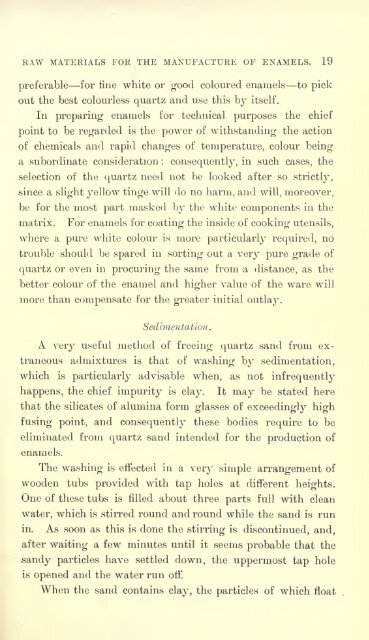Enamels and enamelling; an introduction to the preparation and ...
Enamels and enamelling; an introduction to the preparation and ...
Enamels and enamelling; an introduction to the preparation and ...
You also want an ePaper? Increase the reach of your titles
YUMPU automatically turns print PDFs into web optimized ePapers that Google loves.
EAW MATERIALS FOR THE MANUFACTURE OF ENAMELS. 19<br />
preferable for fine white or good coloured enamels <strong>to</strong> pick<br />
out <strong>the</strong> best colourless quartz <strong><strong>an</strong>d</strong> use this by itself.<br />
In preparing enamels for technical purposes <strong>the</strong> chief<br />
point <strong>to</strong> be regarded is <strong>the</strong> power of withst<strong><strong>an</strong>d</strong>ing<br />
<strong>the</strong> action<br />
of chemicals <strong><strong>an</strong>d</strong> rapid ch<strong>an</strong>ges of temperature, colour being<br />
a subordinate consideration ; consequently, in such cases, <strong>the</strong><br />
selection of <strong>the</strong> quartz need not be looked after so strictly,<br />
since a slight yellow tinge will do no harm, <strong><strong>an</strong>d</strong> will, moreover,<br />
be for <strong>the</strong> most part masked by <strong>the</strong> white components in <strong>the</strong><br />
matrix. For enamels for coating <strong>the</strong> inside of cooking utensils,<br />
where a pure white colour is more particularly required, no<br />
trouble should be spared in sorting out a very pure grade of<br />
quartz or even in procuring <strong>the</strong> same from a dist<strong>an</strong>ce, as <strong>the</strong><br />
better colour of <strong>the</strong> enamel <strong><strong>an</strong>d</strong> higher value of <strong>the</strong> ware will<br />
more th<strong>an</strong> compensate for <strong>the</strong> greater initial outlay.<br />
Sedimentation.<br />
A very useful method of freeing quartz s<strong><strong>an</strong>d</strong> from ex-<br />
tr<strong>an</strong>eous admixtures is that of washing by sedimentation,<br />
which is particularly advisable when, as not infrequently<br />
happens, <strong>the</strong> chief impurity is clay. It may be stated here<br />
that <strong>the</strong> silicates of alumina form glasses of exceedingly high<br />
<strong>to</strong> be<br />
fusing point, <strong><strong>an</strong>d</strong> consequently <strong>the</strong>se bodies require<br />
eliminated from quartz s<strong><strong>an</strong>d</strong> intended for <strong>the</strong> production of<br />
enamels.<br />
The washing is effected in a very simple arr<strong>an</strong>gement of<br />
wooden tubs provided with tap holes at different heights.<br />
One of <strong>the</strong>se tubs is filled about three parts full with cle<strong>an</strong><br />
water, which is stirred round <strong><strong>an</strong>d</strong> round while <strong>the</strong> s<strong><strong>an</strong>d</strong> is run<br />
in. As soon as this is done <strong>the</strong> stirring is discontinued, <strong><strong>an</strong>d</strong>,<br />
after waiting a few minutes until it seems probable that <strong>the</strong><br />
s<strong><strong>an</strong>d</strong>y particles have settled down, <strong>the</strong> uppermost tap hole<br />
is opened <strong><strong>an</strong>d</strong> <strong>the</strong> water run off.<br />
When <strong>the</strong> s<strong><strong>an</strong>d</strong> contains clay, <strong>the</strong> particles of which float
















